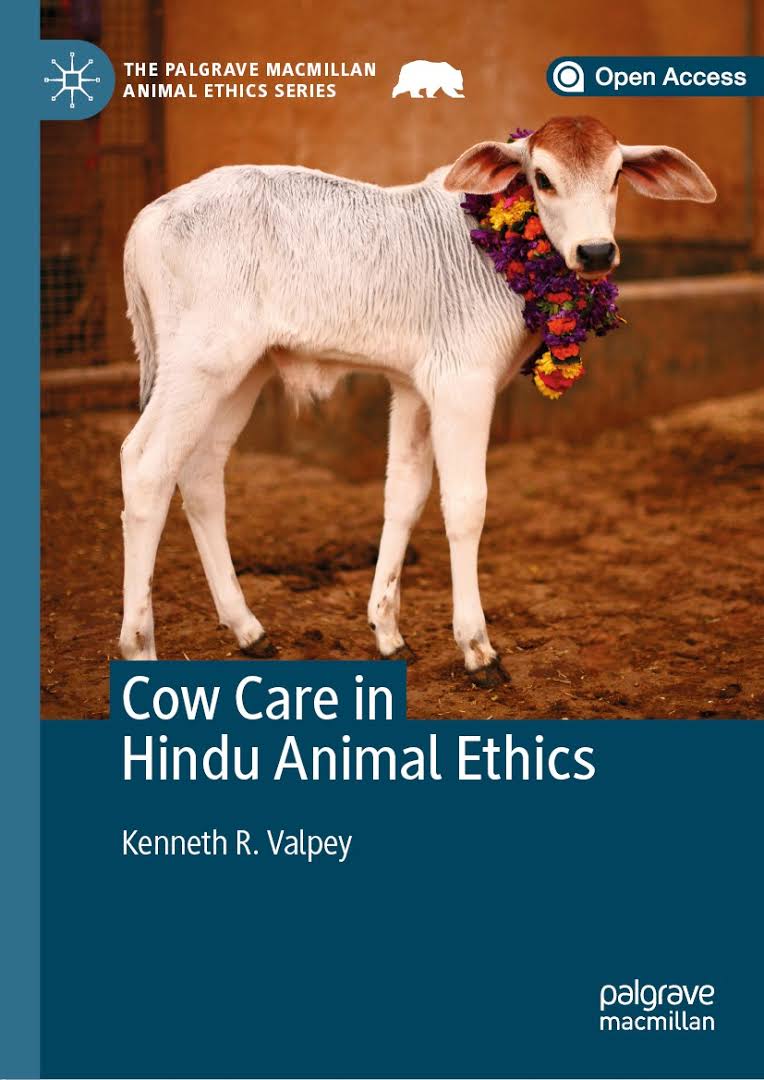That the cow is holy in Hinduism is a trite truism, but how did she attain that position, and what does holding her sacred mean in terms of animal ethics? What happens when we consider bovines as subjects in their own right? These are some of the questions that Krishna Kshetra Swami explores in Cow Care in Hindu Animal Ethics (Palgrave McMillan 2020).
As the title itself indicates, Cow Care in Hindu Animal Ethics is not a book primarily targeted at a Vaishnava audience, but rather at persons interested in animal ethics in general. Nevertheless, it is a book that deserves to be read carefully by any Vaishnava interested in cow care. Srila Prabhupada was famously upset at his early editors for changing his translation of go-raksya (in Gita 18.44) from “cow protection” to “cattle raising”, as he felt that the latter term implied not only raising cows but also killing them. For Srila Prabhupada, as anyone having read his books well knows, protecting and caring for cows was a major concern.

Apart from an introduction and a conclusion, Krishna Kshetra Maharaja’s book contains five chapters. The first, “The Release of Cosmic Cows,” follows the portrayal of cows–or better, bovinity, to use Maharaja’s playfully coined word–in Indian texts from the Rgveda to Gita Press’ semi-periodical Kalyana. The second chapter, “Cows in Contested Fields,” continues this historical survey by surveying the Indian Cow Protection movement of the 20th century through four influential persons variously related to it, that is, Swami Dayananda Saraswati, M.K. Gandhi, B.R. Ambedkar and Srila Prabhupada. Through these thinkers, Maharaja identifies different narratives concerning the contentious question of animal sacrifice in Vedic times and how to relate such sacrifice to the ideal of ahimsa–narratives that influence current politics and treatment of cows in India.
The third chapter, “Surveying the Cow Care Field,” looks at several projects of providing bovines with protection for the duration of their natural lives. The main focus is here on projects in North and West India. ISKCON readers will be pleased to find many ISKCON projects and individuals featured, such as Care For Cows in Vrindavan, Govardhan Eco Village north of Mumbai, and Hrimati Dasi near Mayapur.
In some ways, the fourth chapter lies at the heart of the book, as it is here that Krishna Kshetra Maharaja makes contemporary Western animal ethics (drawing primarily on the concept of the “citizenship” of domestic animals put forward by Sue Donaldson and Will Kymlicka) and Indian thought (primarily the ideas of dharma, yoga, and bhakti) speak to each other. What is particularly inspiring here is that Maharaja avoids the common mistake of starting out with a modern idea (e.g., social equality) and then cherry-picking quotes from ancient scriptures to support it.
In the fifth and last chapter (barring the conclusion), “These Cows Will Not Be Lost: Envisioning a Care-Full Future for Cows,” takes up the challenge of what cow care should look like in the future. For his main inspiration, the author here moves beyond the borders of India to the New Vraja Dham community in Hungary lead by Shivarama Swami, but this chapter also deals with potentially divisive issues, such as allowing bovines to die a natural death vs. Western ideas of euthanizing terminally ill animals. In this chapter, the author also deals with the controversial (to say the least) activities of contemporary cow protection groups in India. Maharaja ends the chapter with an overview of what he calls cow protection in the three qualities (guna) and a list of six affirmations on the Dharma of cow care, that is, “present-tense positive as-if statements that aid in sparking the imagination to envision a possible better future that is rooted in the pursuit of self-integrity.”
While sure to provide inspiration and perhaps also some ideas for fundraising for protected cows, Krishna Kshetra Maharaja’s book should not be seen as a manual for how to manage a goshala, train oxen, or provide cows with the perfect diet. Maharaja himself admits to having little practical knowledge of cow care. While providing plenty of citations from sacred texts on the sanctity of the cow, particularly in the first, historical chapters, neither is this a book for converting cow-eaters into cow-worshippers. For such purposes, other books will serve better. In fact, some Vaishnavas might find the academic language and style of the book difficult. For such a person, I recommend beginning at the end of the book with the author’s “Concluding Ruminations”, where he takes the reader from a dystopic Kali-yuga all the way to Vraja Vrindavana.
What Maharaja does in this book, then, is to bring cow care into the 21st century by pairing it with modern animal ethics. Updating the way in which Vaishnavas think and speak about cow care has been long overdue. As Maharaja shows, the “abolitionist” view of animal care, championed by many vegans, for example, is not the only ethically supportable way to view the relationship between humans and domestic animals.
However, this pairing works in both directions. Not only should this book be compulsive reading for Vaishnavas wishing to create policies around goshalas and temple milk consumption, but it should also be read by anyone interested in non-Western perspectives on animal ethics. And in a world more and more waking up to the need of challenging the hegemony of the Western mind, this is sorely needed. Finally, Krishna Kshetra Swami should be congratulated for arranging to publish his book in open access. Scholarly books such as this are usually very expensive, putting them out of reach of many readers. This book is freely available to anyone wishing to download it. Judging from the number of downloads reported on its homepage, this decision has already proved a fortunate one.
Source: https://harmonist.us/2020/06/review-cow-care-in-hindu-animal-ethics